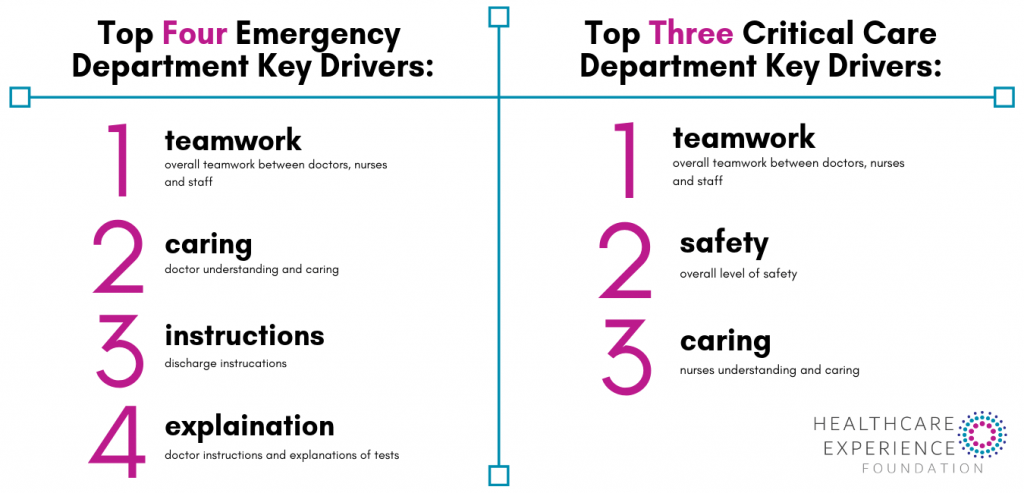Top Lessons in Loyalty for Emergency and Critical Care Departments
Patients who perceive caregivers as working cooperatively are more likely to return to and recommend healthcare facilities.
We recently had the opportunity to publish findings to create patient loyalty in the Emergency Department and Critical Care environments. Both care settings represent some of the most intense environments where patients face potentially life-threatening illness and rare symptoms. At any given moment, staff and physicians must be prepared for the unpredictable. In an industry where quality and the patient experience are crucial performance indicators of success, our team set out to provide pragmatic guidance to care teams who are seeking to create a climate the produces patient loyalty.

Across both the Emergency Department and Critical Care Unit patients, perceptions of teamwork between doctors, nurses, and the staff were the number one key driver impacting patient loyalty.
The study was completed using retrospective patient experience survey data from 2016 to 2019 for patients discharged from 441 emergency departments and 40 critical care units. On average, perceived teamwork explained 69% of the variation of patient loyalty in the Emergency Department and 55% of the variation of patient loyalty in the ICU.
The study identified Key Drivers of Excellence; attributes of the patient experience statistically demonstrated to influence perceptions of patient loyalty.

When patients perceive their care as excellent in attributes such as teamwork, understanding and caring, level of safety, discharge instructions, and instructions/explanations of tests, hospitals’ efforts will be rewarded with patient loyalty in these high acuity environments.
This research helps our Healthcare Experience Foundation team hone our focus to help leaders, staff, and physicians improve performance with the patient experience. For leaders working to create loyalty among patients and family members, we recommend focusing on the following:
Project Teamwork: Patient care in the Emergency and Critical Care Departments requires the highest levels of teamwork from a myriad of healthcare professionals. All too often we assume that the patient and family knows how we are coordinating their care and what happens “behind the scenes”. Our findings indicate is that teamwork must be displayed and evident in interactions with patients. We must explain how we are working together to provide the safest, highest quality of care.
Communication. Communication. Communication.: Our research elevated the importance of both physician and nurse communication in interactions with patients. It is important to both demonstrate caring and understanding behaviors consistently every patient, every time. We recommend perspective taking activities to anticipate the patient’s needs for communication to enhance their confidence in their care and care team. Each interaction (regardless of frequency) can make or break the patient’s experience of care and subsequently their loyalty to our organizations.
Engage Your Care Team: It is important to personalize your performance results with the staff and physicians in the departments. Review areas of patient experience success, as well as opportunities for improvement. We cannot assume the staff understands how patients perceive care if we do not take the time to have meaningful conversations using patient experience data and comment results.
Engage Your Patients and Families: Our findings illuminate key aspects of care that matter to creating loyalty. Take time as leaders to listen to patients and inquire about these aspects of care. Asking open-ended questions such as,
“Tell me about when we display the most teamwork.”
“What are the ways we can do a better job as a team caring for you.”
“Is there anyone that you would like me to recognize that is excellent at being caring and understanding?”
“Are there times we could have shown you better care and understanding?”
While asking these questions may feel awkward at first, we are highly confident the answers will lead to rich patient feedback and afford you the chance to coach and develop your team.
Build a Healthy Team: Earlier we recommended projecting teamwork; it is equally important to live the part and be a healthy team. Focusing on team strengths can create a collaboration that excels in trust and psychological safety. Exercises from “Walk a Mile in My Shoes” to our Healthcare Experience Foundation’s TeamStrengths program can work to build relationships within teams and interprofessionally across departments. We are privileged to work with many extraordinary teams who excel in providing excellent care to Emergency and Critical Care department patients. It is humbling to see care teams manage and excel in some of the most intense and acute care environments where patients face potentially life-threatening illness and unique symptoms. By focusing on Key Drivers, you can accelerate a path to improvement and taking the experience to the next level. Download a copy of this research.
For more information on how the Healthcare Experience can support your patient experience strategy, contact Barry Fleming.
- Posted in:
- News



